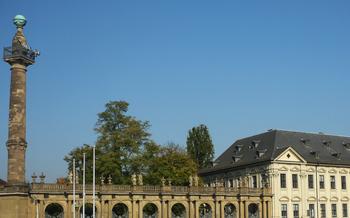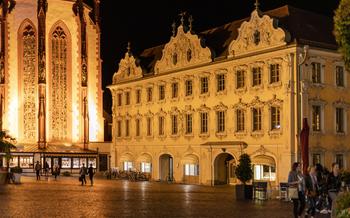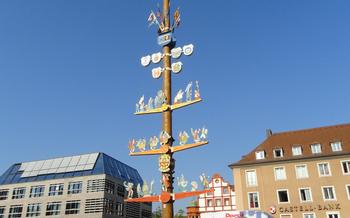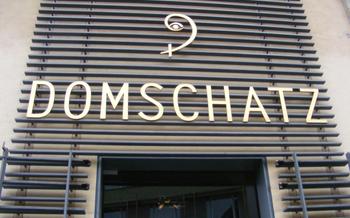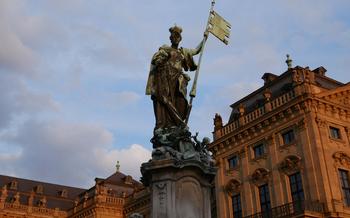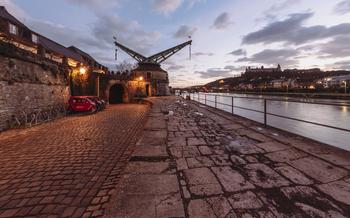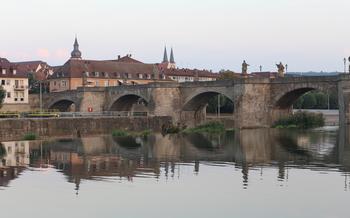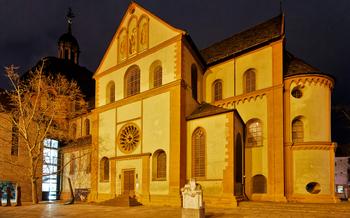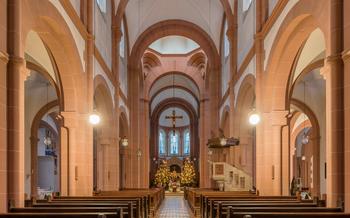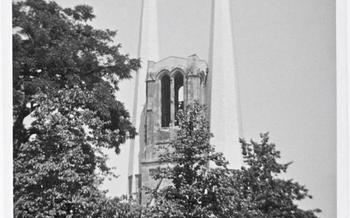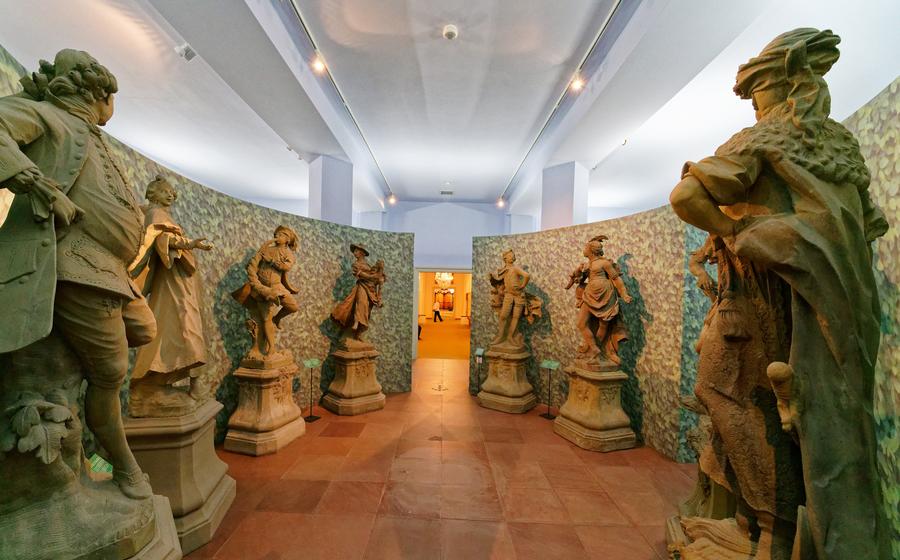
Museum für Franken
- Würzburg's Historical Gem: Museum für Franken
- Journey Through Time: Prehistoric and Ancient Collections
- Medieval Masterpieces: Art and Craftsmanship
- Treasures of the Prince-Bishops: Ecclesiastical Splendor
- Regional Folk Art and Traditions: A Cultural Tapestry
- Arms and Armor: A Legacy of Defense and Warfare
- Natural Wonders: Exploring Franconia's Landscapes
- Temporary Exhibitions: A Dynamic Showcase
- Educational Programs: Fostering Knowledge and Engagement
- Immersive Experiences: Bringing History to Life
- Research and Conservation: Preserving Heritage
- Museum Shop: Unique Souvenirs and Treasures
- Accessibility and Inclusivity: Welcoming All Visitors
- Planning Your Visit: Essential Tips
- Insider Tip: Hidden Gems and Secret Spots
Würzburg's Historical Gem: Museum für Franken
In the heart of Würzburg, nestled amidst cobblestone streets and baroque architecture, lies a treasure trove of Franconian history and culture—the Museum für Franken. Established in 1832, this venerable institution has become an integral part of the city's cultural landscape, offering visitors a captivating journey through time and heritage.
The museum's impressive neo-Gothic facade, adorned with intricate carvings and sculptures, hints at the wonders within. Inside, a world of discovery unfolds, with exhibits encompassing prehistoric artifacts, medieval masterpieces, ecclesiastical treasures, and regional folk art, all meticulously curated to showcase the diverse cultural heritage of Franconia.
Easily accessible by foot or public transportation, the Museum für Franken is a must-visit destination for history enthusiasts, art lovers, and anyone seeking a deeper understanding of the region's rich past. Its affiliation with the University of Würzburg and collaborations with other museums and institutions ensure a high standard of scholarship and research, making it a valuable resource for students, scholars, and the general public alike.
Journey Through Time: Prehistoric and Ancient Collections
The Museum für Franken takes visitors on a captivating journey through time, showcasing the rich history of the region from its prehistoric origins to the ancient world. The prehistoric and ancient collections offer a glimpse into the lives and customs of early civilizations that shaped the Franconian landscape.
Exhibits display an array of artifacts from the Stone Age, Bronze Age, and Iron Age, providing insights into the technological advancements and cultural practices of these periods. Visitors can marvel at intricate tools, weapons, and pottery that reveal the ingenuity and craftsmanship of our ancestors.
The museum also sheds light on the Celtic and Roman settlements that left an indelible mark on the region. Discover the fascinating remains of their daily lives, including jewelry, coins, and household items that tell the story of their interactions and influences.
Interactive displays enhance the museum experience, allowing visitors to delve deeper into the prehistoric and ancient world. Touchscreens, interactive maps, and multimedia presentations bring history to life, creating a truly immersive and engaging learning environment.
Medieval Masterpieces: Art and Craftsmanship
The Museum für Franken boasts an exquisite collection of medieval art that transports visitors back to a time of unparalleled craftsmanship and creativity. Sculptures, paintings, and tapestries from the region adorn the halls, each telling a unique story of the artistic achievements of the period.
Highlights of the collection include intricate wooden sculptures from the Gothic era, depicting religious figures with remarkable detail and emotion. The Gemäldegalerie (Picture Gallery) houses a treasure trove of medieval paintings, showcasing the vibrant colors and skillful brushwork of master artists. Visitors can admire serene Madonnas, expressive portraits, and vivid depictions of biblical scenes.
The museum also features a collection of beautifully preserved tapestries, woven with gold and silver threads to create opulent and colorful narratives. These tapestries, often commissioned by wealthy patrons, served as decorative elements in churches and castles, adding a touch of luxury and grandeur to the medieval world.
Exploring the medieval art collection at the Museum für Franken is a journey through time, allowing visitors to witness the exceptional skills and artistry of the craftsmen and women who shaped the visual culture of the Middle Ages. These masterpieces offer a glimpse into the spiritual, social, and cultural values of a bygone era, inviting visitors to connect with the rich history and heritage of Franconia.
Treasures of the Prince-Bishops: Ecclesiastical Splendor
The Museum für Franken houses an impressive collection of artifacts from the Würzburg Cathedral and other churches in the region. These treasures, once belonging to the prince-bishops of Würzburg, offer a glimpse into their lavish lifestyle and the profound influence they wielded.
Elaborately crafted liturgical objects, such as chalices, monstrances, and reliquaries, showcase the exquisite craftsmanship of the era. Visitors can admire intricate goldsmith work, enamel decorations, and precious gemstones that adorn these sacred vessels.
The vestments worn by the prince-bishops during religious ceremonies are a testament to their opulence and power. Embroidered with gold threads, adorned with pearls and jewels, these garments exude an aura of grandeur and authority.
Through these artifacts, the museum provides insights into the lives of the prince-bishops, who were not only spiritual leaders but also powerful political figures. Their influence extended beyond religious matters, shaping the cultural and economic landscape of the region.
The collection also delves into the symbolism and religious significance of these treasures. Each object holds a deeper meaning, representing aspects of faith, power, and devotion. Visitors can explore the stories behind the artifacts and gain a deeper understanding of the beliefs and practices of the time.
Regional Folk Art and Traditions: A Cultural Tapestry
The Museum für Franken also offers an immersive journey into the rich tapestry of regional folk art and traditions. Exhibits showcase the diverse cultural heritage of Franconia, shedding light on the region's customs, festivals, music, and dance. Visitors can admire traditional costumes, intricate pottery, and handcrafted items that reflect the creativity and artistry of local artisans. Interactive displays provide a hands-on experience, allowing visitors to engage with the region's cultural heritage in a personal and interactive way.
Displays on traditional festivals and events bring the vibrant spirit of Franconian culture to life. Visitors can learn about the region's unique celebrations, such as the Würzburg Kiliani Volksfest, a centuries-old fair that attracts visitors from near and far. The museum also highlights the region's rich musical traditions, showcasing traditional instruments and showcasing local musicians.
The museum's collection of folk art and traditions provides a fascinating glimpse into the daily lives and customs of the people of Franconia. It celebrates the region's unique identity and heritage, offering visitors an opportunity to connect with the past and gain a deeper understanding of the present.
Arms and Armor: A Legacy of Defense and Warfare
The Museum für Franken also boasts an impressive collection of arms and armor from the Middle Ages and early modern period. Suit up in awe at the gleaming suits of armor that once protected knights and warriors on the battlefields of Franconia. Marvel at the intricate designs and craftsmanship of swords, daggers, and polearms that were wielded in battles that shaped the region's history.
Discover the rich stories behind each weapon, from the personal sidearms of noblemen to the standard issue equipment of foot soldiers. Interactive displays allow you to virtually experience the thrill of combat, putting you in the shoes of a medieval warrior facing the clash of steel. Whether you're a history buff, a fan of medieval culture, or simply fascinated by the art of warfare, this section of the museum is sure to leave you in awe.
Natural Wonders: Exploring Franconia's Landscapes
Venture into the heart of Franconia's natural wonders at the Museum für Franken. Discover the region's diverse flora and fauna through captivating exhibits that showcase local habitats and ecosystems. Immerse yourself in the beauty of Franconia's landscapes through intricate dioramas, interactive displays, and educational programs designed to foster environmental awareness. Learn about the delicate balance of nature and the importance of preserving the region's rich biodiversity. From towering forests and tranquil lakes to vibrant meadows and rugged hills, the museum offers a journey through the natural wonders that define Franconia.
Temporary Exhibitions: A Dynamic Showcase
The Museum für Franken doesn't limit itself to its permanent collections. It also offers a vibrant platform for temporary exhibitions that explore a diverse range of themes, showcasing contemporary art installations, cutting-edge displays, and collaborations with international institutions. These exhibitions provide a dynamic and ever-changing landscape within the museum, offering visitors new perspectives and insights into art, history, and culture.
Temporary exhibitions often focus on specific historical periods, artistic movements, or cultural phenomena, delving deeper into the region's rich heritage. They present innovative interpretations of past events, challenge traditional narratives, and encourage critical thinking. Collaborations with renowned museums and institutions bring in fresh perspectives and expertise, fostering a cross-pollination of ideas and knowledge.
Contemporary art installations push the boundaries of artistic expression, showcasing the works of emerging and established artists who challenge conventions and provoke thought. Cutting-edge displays employ interactive technologies, multimedia presentations, and immersive experiences to engage visitors and create lasting impressions.
Temporary exhibitions at the Museum für Franken are not just passive displays; they are dynamic spaces for dialogue, debate, and exploration. They invite visitors to engage with the past, present, and future of art, history, and culture, fostering a sense of wonder and curiosity.
Educational Programs: Fostering Knowledge and Engagement
The Museum für Franken extends its mission beyond artifact preservation and display to encompass educational initiatives that foster knowledge and engagement with regional history and culture. Guided tours, tailored to diverse audiences, provide visitors with expert insights into the museum's collections. Whether exploring the prehistoric exhibits with school groups or delving into the intricacies of medieval art with history enthusiasts, these tours create a dynamic and interactive learning experience.
Workshops and seminars cater to those seeking a deeper understanding of specific topics. From hands-on pottery sessions to lectures on Franconian folklore, these programs offer a platform for participants to engage with experts, exchange ideas, and expand their knowledge.
Recognizing the importance of educational resources for educators, the museum provides a treasure trove of materials. Teachers can access lesson plans, teaching guides, and interactive tools to incorporate regional history and culture into their curricula. Engaging activities, such as scavenger hunts and interactive quizzes, make learning fun and memorable for students of all ages.
Families and children are not forgotten in the museum's educational endeavors. Interactive displays, designed to spark curiosity and encourage exploration, invite young minds to engage with the past in a playful and immersive way. The museum's commitment to fostering knowledge and engagement ensures that the rich heritage of Franconia continues to inspire and educate generations to come.
Immersive Experiences: Bringing History to Life
The Museum für Franken doesn't just present artifacts; it brings history to life through immersive experiences that transport visitors to another time. Costumed reenactors, dressed in authentic attire, embody historical figures and engage visitors in lively conversations, providing a glimpse into the past. The museum also hosts thematic events and festivals that showcase regional culture, allowing visitors to immerse themselves in traditional music, dance, and local customs. For a virtual journey through time, the museum offers state-of-the-art virtual reality experiences that take visitors on an interactive adventure through Würzburg's rich history. Sensory and interactive displays further enhance the immersive experience, engaging multiple senses and creating a multi-dimensional journey through the ages.
Research and Conservation: Preserving Heritage
The Museum für Franken plays a crucial role in preserving and restoring the rich cultural heritage of Franconia. The museum's dedicated team of conservators works tirelessly to conserve and restore artifacts, ensuring their preservation for future generations. Their expertise extends to various materials, including textiles, metals, ceramics, and paintings, ensuring that each artifact receives the specialized care it requires.
In addition to conservation efforts, the museum also engages in extensive research projects. These projects, often conducted in collaboration with universities and research institutions, delve into the history, significance, and context of the museum's artifacts. Through this research, the museum contributes to the advancement of knowledge about Franconia's past and its cultural heritage.
The museum's commitment to preserving and researching Franconian cultural heritage extends to digitization and documentation efforts. By digitizing artifacts and creating comprehensive documentation, the museum ensures that this valuable knowledge is accessible to researchers, scholars, and the public worldwide. This digital preservation also safeguards the museum's collection against potential risks, such as natural disasters or theft.
Museum Shop: Unique Souvenirs and Treasures
The Museum für Franken's gift shop is a treasure trove of unique souvenirs and mementos that will remind you of your visit to Würzburg. Here, you can browse a carefully curated selection of books, postcards, and replicas of museum artifacts, allowing you to take a piece of Franconia's rich history and culture home with you.
The shop also features a range of locally crafted souvenirs, from traditional pottery and handicrafts to regional delicacies and treats. These items are not only beautiful but also support local artisans and businesses, ensuring that the museum's impact extends beyond its walls.
Whether you're looking for a thoughtful gift for a loved one or a special keepsake for yourself, the Museum für Franken gift shop has something for everyone. By making a purchase, you not only support the museum's ongoing efforts but also contribute to the preservation and promotion of Franconia's cultural heritage.
Accessibility and Inclusivity: Welcoming All Visitors
The Museum für Franken is committed to providing an accessible and inclusive experience for all visitors. Recognizing that cultural heritage should be accessible to everyone, the museum has taken several measures to ensure that visitors with disabilities can fully enjoy their time at the institution. Barrier-free access is provided throughout the museum, including ramps, elevators, and accessible restrooms, ensuring that visitors with mobility impairments can navigate the space with ease.
For visitors who are deaf or hard of hearing, guided tours in sign language are available, allowing them to engage with the museum's collections and stories in their preferred communication mode. Additionally, audio guides are available in multiple languages, enabling visitors from various backgrounds to access information about the exhibits in their native tongue.
The museum also recognizes the importance of inclusivity for visitors with cognitive disabilities. Educational programs are tailored to accommodate diverse learning styles and needs, ensuring that everyone can engage with the museum's content in a meaningful way. The museum's commitment to accessibility and inclusivity extends to its online presence, with its website and digital resources designed to be accessible to all users, regardless of their abilities. This dedication to creating an inclusive environment allows the Museum für Franken to fulfill its mission of sharing the region's rich cultural heritage with a broad audience.
Planning Your Visit: Essential Tips
Recommended Duration: To fully appreciate the museum's diverse collections, plan for a minimum of two to three hours. This will allow you to explore the permanent exhibits, immerse yourself in the temporary exhibitions, and engage with the interactive displays.
Best Time to Visit: To avoid crowds and ensure a more intimate experience, plan your visit for a weekday morning or early afternoon. The museum is typically less busy during these times, providing a more relaxed atmosphere to explore the exhibits.
Combining Attractions: Würzburg offers a wealth of cultural and historical attractions beyond the Museum für Franken. Consider combining your visit with a stroll through the UNESCO World Heritage-listed Residenz, a tour of the opulent Würzburg Cathedral, or a visit to the nearby Marienberg Fortress.
Practical Information: The museum is easily accessible by public transportation, with several bus lines stopping nearby. Limited parking is available at the museum, but it's advisable to use public transportation or park in nearby streets. Dining options are available in the museum café or at nearby restaurants.
Insider Tip: Hidden Gems and Secret Spots
Beyond the main attractions, the Museum für Franken holds hidden treasures that offer a unique glimpse into Franconia's rich history. For those who venture off the beaten path, there are several lesser-known exhibits and artifacts that provide fascinating insights.
One such gem is the collection of medieval manuscripts, which includes beautifully illuminated books, personal letters, and historical documents. These manuscripts offer a glimpse into the lives and thoughts of people from a bygone era.
Another hidden gem is the "Franconian Room," which showcases traditional costumes, furniture, and everyday objects from the region. This exhibit provides a glimpse into the daily lives of ordinary Franconians from centuries past.
For those interested in archaeology, the museum's collection of prehistoric tools and weapons is a must-see. These artifacts provide insights into the lives of the region's earliest inhabitants and their struggle for survival in a harsh and unforgiving environment.
To discover these hidden gems, take your time to explore the museum's many nooks and crannies. Ask the friendly museum staff for recommendations and guidance, and be prepared to be amazed by the treasures that await you.
